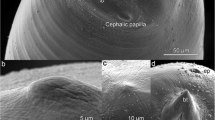Abstract
Dunnifilaria meningica from naturally infectedNeotoma micropus in Mexico were studied by scanning electron microscopy (SEM). The anterior end of adults is surrounded by two pairs of buccal and two pairs of cervical papillae. Two amphidial openings lie near the central mouth opening, surrounded by a thick cuticular ring. The cuticular surface of males and females shows fine transversal striations. At the posterior end of the male is a semicircular cloaca, a large preanal central papilla, two pairs of perianal and two pairs of postanal papillae. The short, strong, and almost equal spicules are rolled plates that end in a knobshaped apex, showing a central groove. In the female, the vulva is located 550 μm from the anterior end. The inconspicuous anus is subterminally situated in the right ventrolateral portion of the posterior end. The anterior tip of the sheathed microfilariae is formed by a cap-like cephalic disk. Cuticular annulations were clearly demonstrated across the body.
Similar content being viewed by others
References
Aoki Y, Katamine D (1975) Scanning electron microscopic observations onDirofilaria immitis. Trop Med 17:27–34
Franz M, Lenze W (1982) Scanning electron microscope study of adultBrugia malayi. Tropenmed Parasitol 33:17–22
Franz M, Zielke E (1980) Scanning electron microscope study on larvae ofWuchereria bancrofti from the vector and from experimental rodent hosts. Tropenmed Parasitol 31:345–356
Gutiérrez-Peña EJ (1987)Dunnifilaria meningica sp. n. (Filarioidea: Onchocercidae) from the central nervous system of the wood rat (Neotoma micropus) in Mexico. Tropenmed Parasitol 38:294–298
Kozek WJ, Orihel TC (1983) Ultrastructure ofLoa loa microfilaria. Int J Parasitol 13:19–43
Lian-Yin H, Ash LR, Voge M (1984) Scanning electron microscope studies of adults, first- and third-stage larvae ofAngiostrongylus cantonensis (Nematoda: Metastrongyloidea). Proc Helminthol Soc Wash 51:85–91
Lichtenfels JR, Murrell KD, Pilitt PA (1983) Comparison of three subspecies ofTrichinella spiralis by scanning electron microscopy. J Parasitol 69:1131–1140
Mak JW, Weaver RE (1979)Dunnifilaria dilli sp. n (Nematoda: Filarioidea) fromRattus koratensis in Thailand., J Helminthol 53:73–78
Martínez-Palomo A, Martínez-Báez M (1977) Ultrastructure of the microfilaria ofOnchocerca volvulus from Mexico. J Parasitol 63:1007–1018
Mullin SW, Balasingam S (1973)Dunnifilaria ramachandrani gen. n., sp. n. (Nematoda: Filarioidea) from the long-tailed giant rat (Rattus sabanus) in Malaysia. Proc Helminthol Soc Wash 40:47–49
Shoho C, Uni S (1977) Scanning electron microscopy (SEM) of someSetaria species (Filarioidea, Nematoda). Z Parasitenkd 53:93–104
Author information
Authors and Affiliations
Rights and permissions
About this article
Cite this article
Gutiérrez-Peña, E.J. Scanning electron microscopic study of adults and microfilariae ofDunnifilaria meningica (Filarioidea: Onchocercidae). Parasitol Res 75, 470–475 (1989). https://doi.org/10.1007/BF00930975
Accepted:
Issue Date:
DOI: https://doi.org/10.1007/BF00930975




